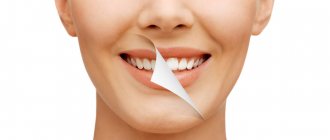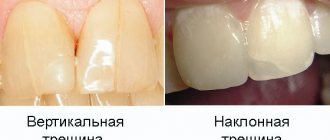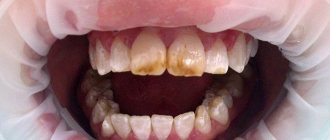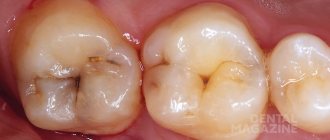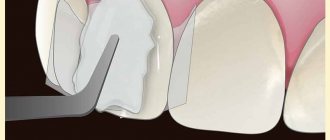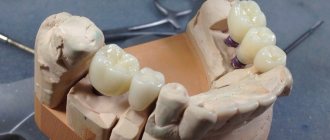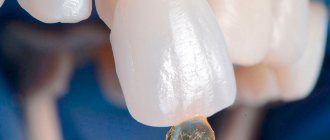December 1, 2021
The desire of modern people to have a beautiful smile is understandable, because it indicates health and youth, helps to establish connections, facilitates understanding and increases self-confidence. And today various companies are successfully “playing” on this desire, offering affordable removable veneers. What do onlays look like before and after installation on teeth? Is it worth buying them or is it better to give preference to designs installed in the dentist’s office? The editors of the UltraSmile.ru portal propose to examine the topic in today's article.
What can we learn about removable veneers and their advantages?
What kind of design is this and its features
What kind of dentures are these and how are removable dentures different from all the others? Removable veneers are veneers that can be removed. It would seem nothing complicated. But in this simplicity lies either an advertising ploy - it misleads patients, or such veneers will soon have to be replaced with permanent ones - which in theory they should be.
It is worth saying that not a single self-respecting orthopedic dentist will offer a patient removable “veneers” as an option to improve the aesthetics of a smile. What's the point here? In general, veneers1 are non-removable microprostheses - overlay plates on the upper and lower front teeth, which make them more beautiful in shape and shade. But such onlays are made in a dental laboratory (this is important!) within a few days or weeks. During this time, the patient is given temporary plates - composite or plastic, which will soon be removed. They are needed to protect the ground teeth from damage and temporarily give them a natural look.
Those removable veneers that are offered to patients on websites on the Internet or in advertising videos and booklets are most often similar to conventional silicone dentures for the entire jaw. They also resemble the joke “jaws” that people wear to masquerades, and even chewing gum in the shape of jaws. They attach very poorly to the mouth and, according to patients, they are completely impossible to wear. You can see how “natural and natural” such products look before and after installation - see the photo.
Types of removable “veneers”
This group includes the following types of structures (although not all of them have the right to be called veneers):
- temporary onlays for teeth: patients wear them for about 2 weeks or more - up to 2 months. During this time, permanent onlays are made in the laboratory from ceramics, zirconium dioxide, and ceramic composite. Moreover, for both temporary and permanent overlays, the rule applies - each tooth has its own individual veneer, made from impressions,
- DenMat's Snap-On Smile Dentures: These are temporary dentures that look like veneers or crowns bonded together. They can be worn over the entire dentition or on a “problem” sector. Snap-On Smile not only improves the aesthetics of a smile, but can replace several missing teeth in a row. They are made individually from impressions sent to the manufacturer’s laboratory in the USA,
- removable “veneers” on teeth, “dental onlays” or “false teeth”, which can be purchased on the Internet, pharmacies or cosmetics stores: they look like a silicone prosthesis for the entire row, or single onlays that are glued at home yourself.
As for the last variety, there is no talk here of any individualized approach or taking casts. These “dentures” have a standard shape and are suitable for a person with perfectly straight teeth. But in any case, they will not stick well and will come off with a little pressure. So with such a “Hollywood smile” you can only smile (but even this is not a fact), but you won’t be able to chew food.
%akc72%
Why do you need dental veneers?
Dental onlays make it possible to solve various dental problems; depending on the purpose of installation, they are divided into:
- Therapeutic – used to eliminate defects on the surface of teeth. Installed for cracks in the enamel, thin enamel layer, irregularly shaped teeth, or too wide interdental spaces. The service life of such products is up to five years.
- Orthopedic – placed to straighten the dentition. Budget orthopedic structures can retain their properties for up to 10–12 years, expensive lumineers for up to 20 years.
- Decorative - used as decoration. They do not have a specific service life. There are removable and non-removable decorative structures, made to order or standard stamped.
What materials are they made from?
Overlay removable veneers are made of polymers, silicone, polypropylene, and plastic in light shades. These are inexpensive materials, they are easy to process and can be easily painted in enamel colors. But we must understand that even in professional dentistry such materials are used only on a temporary basis, because they have low performance characteristics. The materials are softer and more fragile than those used for real microprostheses. They also have irregularities and pores on the surface, into which dietary fiber and dyes become clogged.
Why professional veneers cannot be cheap
The cost of veneers is not determined by the whim of dental centers; it is influenced by the following factors:
- Material. The cheapest plates are made of composite, but they are short-lived and dangerous for the enamel, unlike ceramic ones, which look natural and keep teeth healthy for a long time.
- Qualification and experience of a dental technician. Making veneers is a delicate job that requires honed skills and care from a specialist. Layer by layer, the master applies ceramics to the base, which takes several hours for just one overlay.
- High-quality dental equipment. Such equipment must not only be modern and practical, but also meet all safety requirements and international standards. Reliable dental clinics do not skimp on this.
Doctors share a common point of view regarding removable veneers: this invention cannot solve a dental problem, even for a short period of time. Moreover, there is a possibility of adding new problems to yourself. In pursuit of instant results and the desire to save on professional dental care, patients risk harming the health of their teeth.
Advantages and disadvantages
The advantages or benefits, if you can call them that, are that for not very much money you can get a new look for some kind of masquerade or photo shoot. Then there are the disadvantages, which are mentioned by reviews from dentists and people who decide to buy removable dental veneers. The disadvantages of removable dental veneers are as follows:
- poor fixation in the oral cavity,
- the risk of getting into an awkward situation in society,
- not very aesthetic appearance,
- rapid coloring of lining materials with food coloring, tobacco smoke, etc.,
- discomfort when wearing: such pads are made according to a template, so they will be uncomfortable after installation. After all, absolutely every person has their own individual parameters for the shape and inclination of their teeth, their sizes - it is impossible to measure everyone with one “ruler”,
- unpleasant “chemical” smell or taste from materials,
- risk of complications: damaged enamel, pulpitis, injuries to teeth and gums, chemical and thermal burns, allergic reactions to materials, risk of choking on a peeling pad or swallowing remaining adhesive.
“I placed an order in one group and was led by praise and a large audience. And I was very pleased with the price - it was only 500 rubles, to be honest. But on the day I received it, it turns out I was added to the blacklist. And I couldn’t leave my not at all positive review. These turned out to be not veneers at all, but some kind of toys, just to scare children with them. They do not stick to the teeth and fall out constantly. In general, horror!!!"
Marina_99, review from the woman.ru forum
Contraindications to the use of false teeth
Correcting and decorating teeth with onlays or attachments is not suitable for everyone. Dentists do not recommend resorting to such procedures when:
- inflammatory dental diseases accompanied by bleeding gums;
- diseases of the nervous system;
- allergic reaction to the materials used;
- the presence of bad habits - a tendency to grind teeth, chew hard objects and lack of proper hygiene skills.
How to use removable veneers
How to install and remove removable “veneers” will depend on their type. If the product is in the shape of a full jaw, then they are simply put on the teeth from above and removed from them by hand. Some sellers write that you first need to put the structure in hot water for a few minutes - almost boiling water - and then put it on. But in this case, there is a real risk of burning the gums and overheating the dentinal layer (it is located under the enamel), which can provoke pulpitis. Not to mention the discomfort of the installation process - some people report that it is painful or too hot for the teeth.
Removable “veneers”, which imitate real ones in their shape (but are sold in packs of 70 pieces, and are not made individually), are supposed to be fixed with a special adhesive using a brush and tweezers. And all this on your own at home. But if dentists use only professional formulations with proven components, then it is completely unknown what will end up in the package with “veneers”. It will be good if it is harmless glue (even if it comes off quickly). And if you come across a toxic substance that is difficult to remove, you will have to urgently seek medical help.
Caring for dental veneers
If a person uses dental veneers, he should know how to care for them at home. Otherwise, the microprosthesis or decoration will quickly lose its aesthetic properties or break.
Rules for caring for dental veneers:
- After installing onlays in dentistry, you should immediately consult with your doctor about all the intricacies of oral care.
- After dental restoration, it is not advisable to eat very hard foods and viscous products, so as not to damage the lining.
- It is better not to consume foods and drinks that have aggressive and coloring properties (wine, coffee, pomegranates) or consume them in minimal quantities.
- You need to regularly brush your teeth and treat removable veneers with special solutions recommended by your dentist.
- Metal attachments and composite trims need to be polished periodically as their surfaces will scratch and dull over time.
- Several times a year you need to visit the dentist to monitor the condition of the oral cavity and the false teeth themselves, as well as professional cleaning of the products.
Fixed onlays on the chewing or front teeth, glued to dental cement, cannot be removed either at home or in the clinic. If they deteriorate or break, you need to restore the tooth using other methods, for example, placing a crown on top.
The use of false teeth helps a person correct many dental defects and brighten his smile. But the beauty of the dentition is achieved only with proper installation of structures and careful care for them. Therefore, you need to be careful when choosing a dental clinic and the materials used to make the onlays, and after installing them, you should monitor your hygiene and lifestyle.
What is better to choose?
If you understand the question of which removable “veneers” are better, then the only option would be Snap-On Smile dentures. They are made individually and from quality materials. But, since the plant is located in the USA, the patient will have to wait about 1-2 months, and the main waiting time will be spent on transportation. Again, you will have to first visit an orthopedist to take impressions and sanitize the oral cavity. As a result, the final cost of treatment can be close to installing real veneers.
South Korean implant Osstem - from 35,000 rubles.
Hurry up to sign up for a free consultation and lock in promotional prices.
Call now or request a call
Opening hours: 24 hours a day - seven days a week
How much does a “Hollywood” smile cost?
How much do removable dental veneers cost? If you study the offers on various sites, the average price will be 1,200 rubles for a complete “transformation” of your smile. But, as practice and reviews of people who have decided to make such a change in appearance show, this is money down the drain. In reality, such products will not make your smile more beautiful, and they are impossible to wear.
If the patient is interested in the cost of temporary veneers, which need to be worn while the permanent ones are being made, then their cost, as a rule, is already included in the overall price tag. Those. there will be no additional costs. Classic non-removable ceramic onlays for teeth cost from 15 thousand rubles and more - it all depends on the cost of materials and methods of processing them. By the way, if necessary, the doctor will be able to remove them and install new ones if the need arises.
1Gurel G. Ceramic veneers, 2007.
Your questions and answers
QUESTION I bought removable veneers online, but I cannot attach them to my teeth. They fall off constantly. Tell me how to do this better? Alexandra
ANSWER Hello, Alexandra. Unfortunately, there is nothing we can do here. Because these are not veneers at all, but their imitation. Real veneers are installed in dentistry using a special adhesive composition - and remain on it for years. Also, real veneers are made based on impressions of the patient’s dentition, i.e. they are individual and precisely adjusted to the parameters of a particular person. Whereas “veneers from the Internet” are template overlays made according to standards known only to the manufacturers themselves. That's why they don't stick to the teeth. The use of any independently selected adhesives is unacceptable, as this can only harm yourself. Therefore, we do not recommend wearing these products. But you can use them for creativity, crafts - whatever your imagination allows.
Preparing a tooth for a crown
In order to fix a crown or any other restoration option, the tooth must first be treated to remove carious and non-carious formations. This is done in order to prevent the development of complications after prosthetics.
The depth of treatment depends on the degree of damage to the tooth tissue and on the chosen prosthetic option. For example, if we use an all-ceramic crown, this will allow us to preserve more living tooth tissue, while using a crown based on a metal or zirconium frame requires more severe processing.
Tooth processing process
